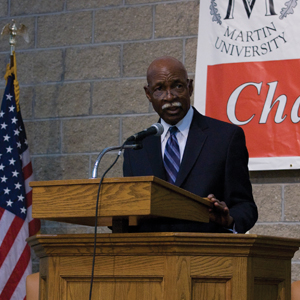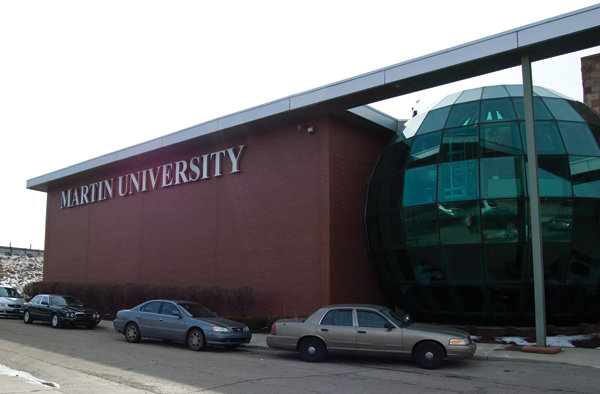Supreme Court sponsors two-part educational program
Martin University student, LaTosha Williams, attended the February 15, 2011 Indiana Supreme Court sponsored event at her university with unanswered questions about the judicial branch of government. “Before today, I was curious about judicial responsibilities and activities. I thought that judges probably sit in their courtrooms every day and make decisions,” she explained.
Williams joined more than 200 people including students, faculty, attorneys and community members for a two-part program about the courts. The first part, “The Least Understood Branch,” was co-sponsored by the Indiana Supreme Court and the American Bar Association (ABA) Judicial Division. The second part, a continuing legal education seminar, was an Indiana Supreme Court Legal History Lecture celebrating Black History Month.

G. Michael Witte, Indiana Supreme Court Disciplinary Commission Executive Secretary, is the ABA Judicial Division Chair. He explained, “We have a number of similar events taking place across the country. The program is designed to initiate discussion and reflection on the role of fair and impartial courts in our society. It is a method of reconnecting the public with the concept of three co-equal independent branches of government.”
The centerpiece of the Least Understood Branch program was a panel discussion on the topic of judicial independence, moderated by Marion County Superior Court Judge David J. Dreyer. Panelists included Federal Court Judge Sarah Evans Barker, US District Court, Southern District of Indiana, Professor John Hill of the Indiana University School of Law—Indianapolis, and Dan Drew, Dean of the School of Journalism at Indiana University—Purdue University Indianapolis.
The panel discussion focused on the role of courts in a democracy and some of the obstacles facing the judicial branch. The areas included judges’ duties, interpretation of the law through case decisions, and the impact of the media and politics on the judiciary. “I learned that judges do much more than simply preside over a trial. They spend a lot of time researching, reading and dealing with many matters beyond the courtroom,” said Williams.

The discussion examined the implications of judges in a political and media-influenced society. Judge Barker stated, “Learning to live with public criticism is a part of a judge’s job. Although it may sometimes entail personally unpalatable results, our job is to apply the law to the case.” Judge Barker’s explanation initiated a conversation about media influence on public opinion. “The media is imperative to an understanding of what is happening in the courts,” explained Dean Dan Drew. “Without media coverage, people will likely not know about these important matters; however, their portrayal of events can influence opinions,” said Drew. The panel consensus was that, because government operates within a system of checks and balances, the role of the judiciary is unique; more than the other two branches, judges must remain impervious to factors beyond the facts and law of a particular case in deciding the controversy before them. “The participants were really beginning to contemplate the roles of the court. They learned about what judges do and the challenges they face every day. Judge Barker illustrated the difficult task judges have to interpret the law in a society where external sources like media and politics are prevalent,” said Judge Dreyer.
After a short break, the program transitioned into a Continuing Legal Education seminar honoring Black History Month. Indiana Supreme Court Justice Robert D. Rucker and Indianapolis lawyer Roderick Morgan, a partner at the firm of Bingham McHale, served as keynote speakers.
Justice Rucker discussed his personal judicial journey, the judicial selection process, and the operation of the Indiana Supreme Court. Justice Rucker explained the role of the Judicial Nominating Commission in choosing Supreme Court justices and the process of becoming a justice. Justice Rucker is only the second African-American to serve on Indiana’s state supreme court. “I had no idea that there were so many factors involved in selecting a Supreme Court justice,” said Williams, who attended both the panel discussion and the black history celebration lectures. “The accomplishments of Justice Rucker are honorable and inspiring and served as a strong foundation for his selection as a justice on the Indiana Supreme Court,” observed Williams.

In the question and answer session, Justice Rucker spoke about the difficult task of enforcing laws while ensuring justice. He noted that, “Justice implies ‘rightness’ but the law does not always allow for flexibility. We must operate within the boundaries of the law. Justice is a goal we try to reach but are sometimes hampered by the law.” He cited a former Indiana Supreme Court justice who ruled in favor of enforcing capital punishment, but as a Quaker was morally opposed to the death penalty. “It is important that we make distinctions between legality and justice. We think about fairness every step of the way,” said Justice Rucker.
Following Justice Rucker’s presentation, Indianapolis attorney and past President of the Indiana State Bar Association Roderick Morgan spoke about the truly remarkable life and career of John Morton Finney, an Indianapolis African American lawyer admitted to the bar in 1935. Mr. Finney practiced law until age 107. During his lifetime, he earned eleven bachelor’s degrees, five law degrees and was fluent in six languages. At the time of his death in 1998, Morton-Finney was the last surviving member of the Buffalo Soldiers, a World War I era black Army unit. Before practicing law, Morton-Finney spent many years as a teacher, department head, and administrator in the Indianapolis Public School system, primarily at Crispus Attucks High School. A few attendees volunteered that they, or their siblings, were former students of Morton Finney and described him a remarkable role model and motivator. The seminar concluded with a discussion about Mr. Finney, segregation, and the importance of celebrating Black History in Indiana.
Dr. Elizabeth R. Osborn, the Indiana Supreme Court’s Director of Courts in the Classroom, helped to organize the CLE portion of the program. She pointed to the different backgrounds of those in attendance, “Attorneys received CLE credit, but they were not the only group represented. The audience was also filled with students, community members and Martin University faculty representing a wide variety of backgrounds and viewpoints. The Indiana Supreme Court strives to achieve this result in all of our programs because it represents the diversity in our state. Our goal is to make the courts better understood by all Hoosiers.”
Martin University Acting President Dr. Charlotte Westerhaus-Renfrow is proud that the school was asked to host this event. “We are certainly appreciative for the community outreach and assisting in helping people better understand and relate to the judicial branch of government. The students felt in touch and up close and personal with the judiciary. The event not only reached out to the community, but also encouraged student participation, which is a great thing,” she said.
Judge Dreyer was also pleased with the program’s successful outcome, “I believe we accomplished our mission of getting people to think about the Courts in our community. The participants will be well prepared to participate in future discussions with a new appreciation for the role of our courts.”
The participants also recognized the value of educational events concerning the judiciary. “The program had a great turnout. It really explored the details about what goes on at the Court. I learned about more opportunities in the Criminal Justice field and ways to get involved and explore the judicial branch,” said Williams. She reflected on her experience and offered some advice for future court outreach. “The Indiana Supreme Court should continue to provide opportunities like this so people can actually learn and experience the importance of the Court during Black History Month,” said Williams.
“We need to listen and be responsive to the needs of the public,” said Judge Dreyer. This program demonstrated that Hoosiers are willing to get involved in the Court and better understand its role in their lives. The Indiana Supreme Court will continue to recognize the importance of celebrating our state’s history while reaching out to interested citizens across our state through programs like the Least Understood Branch.
